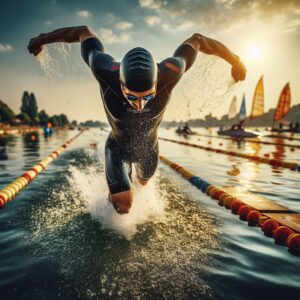Perfecting the Art of Sighting
Sighting too often can tire you out quickly while sighting too little can throw you off course. You need to strike a fine balance. A recommended sighting frequency is every 6-10 strokes. This way, you stay aware of your surroundings and can make minor adjustments to your direction as needed.
When sighting, it’s important to lift your head minimally. You’re looking just to raise your eyes enough to see ahead. The aim is to disrupt your body position as little as possible. Lifting your whole head will create drag, tire you out, and slow you down.
Instead of relying solely on buoys, which can be hard to spot in choppy water or when surrounded by other swimmers, use larger, static landmarks when possible. This could be a distinctive tree, a building, or a hilltop – anything that’s visible from your vantage point in the water and not likely to move.
The sighting should be incorporated into your swimming stroke to maintain efficiency. As you lift your arms out of the water for a stroke, quickly lift your eyes to the horizontal line. Then, as you turn your head to breathe, lower it back into the water. This seamless integration means you can continue to move forward while taking stock of your surroundings.
Dedicate time during your training sessions specifically to work on your sighting technique. Include this practice in both pool and open water settings. In the pool, simulate open-water conditions by not following the lane lines on the bottom of the pool for direction.
The conditions on race day can be unpredictable, and different elements such as sun glare, fog, or waves can all impact your vision. It’s important to anticipate these variables and adjust your sighting technique accordingly.
Managing the Mass Start
Where you position yourself at the start can have a significant impact on your swim. Beginners or less confident swimmers may choose to start at the edges of the pack to avoid the densest areas of activity. This approach can minimize the risk of physical contact and allow for a more controlled beginning. Experienced swimmers, or those who are comfortable with contact and can maintain a faster pace, might opt for a position closer to the center, where the action is concentrated.
 It’s natural to feel a surge of adrenaline as the race begins, but it’s necessary to keep a handle on your initial pace. Sprinting too hard from the start can expend the energy you’ll need later in the race. Establish a steady, sustainable rhythm early on, even amidst the rush of the mass start.
It’s natural to feel a surge of adrenaline as the race begins, but it’s necessary to keep a handle on your initial pace. Sprinting too hard from the start can expend the energy you’ll need later in the race. Establish a steady, sustainable rhythm early on, even amidst the rush of the mass start.
During the mass start, it’s important to maintain a robust and effective stroke. A strong stroke will help you stay buoyant and keep moving forward, even with the additional resistance of other swimmers and potentially choppy water. It can help create a small buffer zone around you, which can be useful for maintaining your own space in the water.
Competitive situations can sometimes lead to anxiety or panic, particularly in the crowded conditions of a mass start. Focus on maintaining composure by taking deep breaths and concentrating on your technique.
Some contact with other swimmers is usually inevitable. It is helpful to mentally prepare for this and decide in advance how you will handle it. Some swimmers find that closing their eyes momentarily upon contact helps maintain concentration on their stroke and breathing patterns.
Be prepared to adjust your route slightly if you find yourself in an area that’s too congested. Sometimes, taking a slightly longer path around a group of swimmers can be faster than trying to go through them, as it avoids being slowed down by turbulence and conflict.
Incorporate race start simulations into your training to get used to the conditions. Practice starts with a group of fellow athletes to acclimatize to the environment, or even simulate the experience by doing quick sprints from a standing start in the pool.
Equipment Essentials
A pair of reliable swim goggles protect your eyes from irritants and improve underwater visibility. When selecting goggles, prioritize comfort, a snug fit to prevent leaking, and clarity of vision. For sunny days, tinted lenses can reduce glare, while in lower light conditions, clear lenses are best. Anti-fog properties are also important, as fogged lenses can hinder your ability to see effectively.
A good wetsuit can enhance buoyancy and hydrodynamic efficiency. When shopping for one, look for a suit that allows for a full range of motion, especially in the shoulders and hips. It should fit tightly to the body but not restrict breathing or movement. The thickness of the wetsuit material may vary according to race regulations and water temperature, so be sure to choose one that complies with the rules of your event.
A swim cap reduces drag, helping swimmers move more smoothly through the water, keeps hair out of the face, and can also provide some degree of warmth in colder waters. Brightly colored caps enhance visibility, making it easier for safety personnel to spot swimmers.
A timing chip strap secures the chip around your ankle throughout the swim, bike, and run portions of the triathlon. The strap should be comfortable, secure, and adjustable to ensure that it stays in place during all the transitions and activities of your race.
Ear plugs can help prevent issues such as swimmer’s ear by keeping water out. They come in various materials and styles, so finding a pair that suits your comfort and needs will be important.
A skin lubricant, or anti-chafe product, can be vital in preventing skin irritation and blistering caused by the repetitive motion of your stroke or the rubbing of a wetsuit. Apply it to areas prone to chafing, such as the neck, armpits, and thighs before suiting up.
Staying Calm in the Chaos
Practice deep, rhythmical inhalations and exhalations during training to make it second nature during the race. When you concentrate on your breathing, it keeps your mind engaged on a familiar task and can help prevent panic or anxiety from taking hold.
Envision yourself swimming with ease through the course, handling potential stressors successfully, and emerging from the water ready for the next stage. Mental practice builds confidence and reduces the fear of the unknown.
At the race’s start, establish your personal space as soon as you can. If you feel crowded, remember that you can use a slightly wider stroke to create a buffer zone around yourself. Bear in mind your stroking doesn’t have to be forceful or aggressive. It just has to signal to others that you are maintaining your space.
Encourage yourself with affirmations or mantras. Reminding yourself of your training and preparation can boost your confidence and focus during challenging moments.
Have a coping strategy ready in case you need to deal with unexpected situations, such as swallowing water or dealing with a kicked goggle. Knowing you have a plan can make these mishaps less likely to disrupt your mental state.
During your training sessions, put yourself in situations that test your composure, like simulated race starts or swimming in crowded conditions. These scenarios become less intimidating, and you learn how to handle your emotional response to them.
